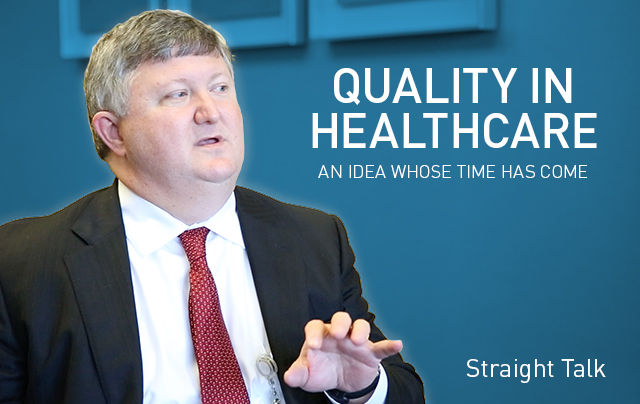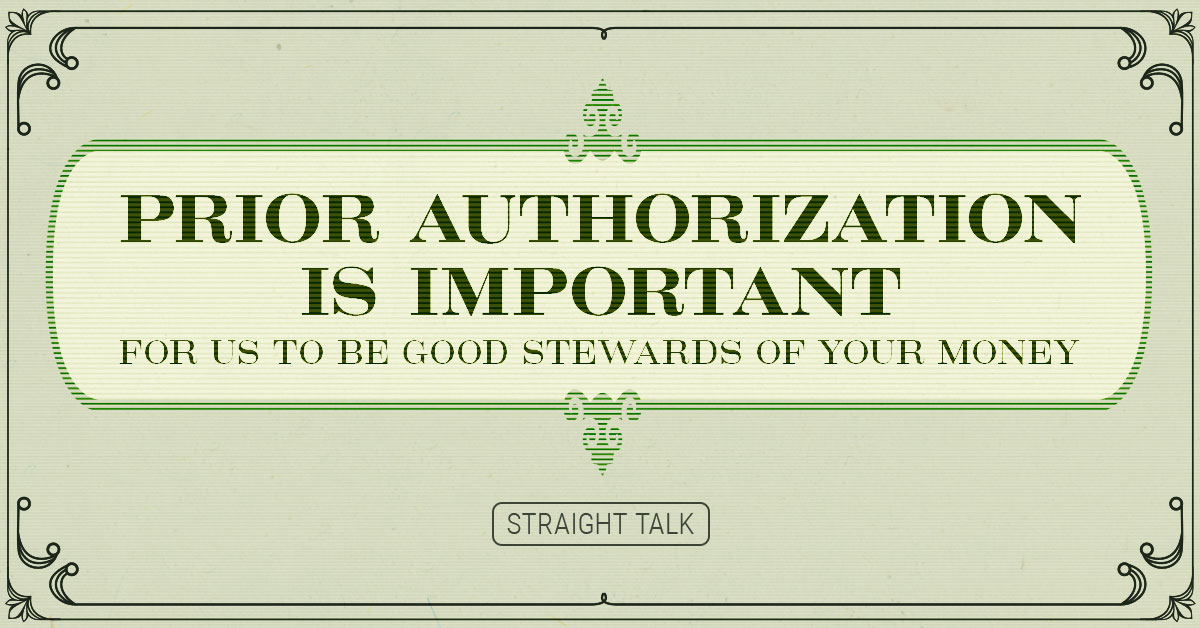Since Americans are spending vast amounts of their personal income on healthcare nowadays, it seems like a good time to start talking about the steps we are taking here at Blue Cross and Blue Shield of Louisiana to improve it.
The Federal Center for Medicare and Medicaid Services (CMS) estimates that, as a nation, we spent right at $3.0 trillion on healthcare in 2014. Sounds like a lot, right? Well, let’s give those numbers the Straight Talk Treatment.
A trillion is one million millions. If I gave you the $3 trillion we spent on healthcare in 2014, and told you to spend it on anything you wanted EXCEPT healthcare, (economists call the second-best use of money the “opportunity cost”), what could you do with $3 trillion?  ]That beautiful yellow machine on the left is the Ferrari F12 TDF. It has a 769hp engine (that’s the power in five Toyota Camrys!) and can reach 212 mph! Price — $400,000! If you decided to spend your $3 trillion on these, how many you can buy? More than seven million of them!
]That beautiful yellow machine on the left is the Ferrari F12 TDF. It has a 769hp engine (that’s the power in five Toyota Camrys!) and can reach 212 mph! Price — $400,000! If you decided to spend your $3 trillion on these, how many you can buy? More than seven million of them!
Enough to give every man, woman and child in Louisiana one and have 2.3 million cars left over.
(Source: Ferrari.com) But maybe you’d rather take a trip?
But maybe you’d rather take a trip?
How about we take you and your 100 closest friends, put you up in the fanciest Disney World hotel, put you on the fanciest meal plan, the best park passes and turn you loose until you and your friends burned through $3 trillion?
How long could you stay? About 141,000 years.
I probably still wouldn’t be tired of the place.
(Source: By ShajiA via Wikimedia Commons)On a more serious note, the economist-run website Hunger Math regularly publishes studies on what it would take to end world hunger for good. Their latest estimate, (which, by their own admission, is probably too high) indicates an annual payment of roughly $1.9 trillion would be plenty to secure enough food to feed every person on earth currently underfed, some three billion people!
In other words, the $3 trillion we spend on healthcare alone in the U.S., properly applied, could guarantee that nobody on earth went to bed hungry at night. That’s a big deal. So the point should be plain by now — we spend world-changing amounts of money on our own healthcare here in the U.S. Surely we are spending enough to demand quality care in return?
I recently sat down with Blue Cross’ (interim) Chief Medical Officer, Dr. Paul Murphree, to discuss exactly why we have an obligation to encourage all this money to be spent responsibly and how quality of healthcare is a huge part of that equation.
Over the next few blogs, I will share with you his thoughts and the amazing progress we are making on that topic today here in Louisiana. And it turns out, nobody but Blue Cross could have made that happen in our state.
“A trillion is one million millions. If I gave you the $3 trillion we spent on healthcare in 2014, and told you to spend it on anything you wanted EXCEPT healthcare, (economists call the second-best use of money the ‘opportunity cost’), what could you do with $3 trillion?”
Murphree explains, “The healthcare system really started to wake up to quality gradually with the publication of two books; the first, called “To Err is Human,” was published by the Institute of Medicine in 1999, and it turned a lot of heads in healthcare.”
Although the focus of the book was patient safety, it pointed out how economic incentives in the system discouraged quality care. Murphree continues, “Let’s say well-meaning docs and nurses want to do something like prevent bed sores. To do that you need better, more expensive beds, and people to turn the patients over every few hours. Problem was, the payments were HIGHER if they DIDN’T prevent the bedsores because of the way hospitals got paid.”
This was a perverse financial incentive that came from the old fee-for-service payment system.
Fee-for-service simply means medical providers get paid for every single thing they do for patients, no matter what the outcome. It’s like checking a laundry list of things and getting paid the same amount for doing them well or not doing them as well. Quality was nowhere to be seen.
In that environment, even preventable complications led to higher payments. Dr. Murphree likens it to an auto repair — “Imagine you have your car up on a lift, and your mechanic changes your oil, but when he lets it down he bends the frame, and then he got paid no questions asked to repair the frame damage. Clearly, he has no incentive to avoid bending more frames.”
“To Err Is Human” resonated within healthcare, and Murphree sees it as Phase One in raising awareness that there was a problem. The key was to create financial incentives for medical providers to do the right thing, instead of letting the system reward them more for causing more harm.
Within a few years, hospital-acquired complications, like operating on the wrong body part or a medication error, were identified. They are often called “never events” because they should never occur. Led by Medicare, payment for them all but disappeared. I remember the first time I read the “never events” list, and it was pretty scary. You can judge for yourself here.
The change to cease payments for additional care caused by these never events was sorely needed. We can think of this as Step One to quality healthcare.
“Imagine you have your car up on a lift, and your mechanic changes your oil, but when he lets it down he bends the frame, and then he got paid no questions asked to repair the frame damage. Clearly, he has no incentive to avoid bending more frames.” – Dr. Paul Murphree
Step Two began with the second book, called “Crossing the Quality Chasm,” published in 2001. It used research to answer the question, “Why are most people in the hospital?” It identified a few long-term, progressive conditions as the biggest culprits. Specifically, the failure to manage bad cholesterol, high blood pressure and high blood sugar/diabetes led to a ton of hospital care.
This realization led to Phase Two in the quest for quality healthcare. Dr. Murphree explains, “Phase Two involves creating value-based healthcare. Clearly, we have to make sure our financial incentives encourage providers to make better care and value based care.”
Louisiana turns out to be fertile ground for improving quality. “We’ve known for a long time that we were not hitting the mark in Louisiana when it came to high blood pressure, diabetes cholesterol and smoking.”
“The downside of not managing these conditions is more strokes, heart attacks, heart failure, and in the long term, kidney failure. This is the beginning of a lot of bad things that can happen to you. Add in smoking, and you accelerate the process,” Murphree told me. (It’s worth noting that 24% of Louisiana adults are tobacco users even today.)
Blue Cross’ version of Phase Two begins with primary care and the Quality Blue Primary Care Program (QBPC: What if we put your docs on commission?).
Best managed by primary care docs, Murphree told me why controlling these conditions was so critical: “. When you have primary care physicians focus on common conditions that have such a dramatic impact on health (like high blood pressure, diabetes, high-cholesterol, and tobacco addiction), you prevent many of the life altering conditions down the road. For example, the combination of high blood pressure and diabetes together, for example, you see much higher incidence of kidney failure. About 70% of our kidney failure patients resulted from not treating their blood pressure and blood sugar to their treatment goals earlier in life.”
“The downside of not managing these conditions is more strokes, heart attacks, heart failure, and in the long term, kidney failure. This is the beginning of a lot of bad things that can happen to you. Add in smoking, and you accelerate the process.” – Dr. Paul Murphree
The focus of QBPC was to encourage docs (through financial incentives) to improve the health of their patients by reaching the established goals for both high blood pressure and blood sugar levels. Avoiding a hospital stay for a heart attack, stroke or heart failure is the ultimate goal.
Since Blue Cross in Louisiana spends well over $1 billion on hospital care each year, this is a very big deal. After two years we can show that it works, and Tulane researchers verified it. “Almost all the savings in the program came from hospital stays that never occurred,” Murphree says.
The bonus from controlling these conditions is to avoid another horrible condition: kidney failure. And a significant bonus in quality of life and money for our insured:
“Dialysis is around $72,000 per year, assuming no complications, going 2-3 times per week. Transplants cost hundreds of thousands of dollars after waiting a long time on a list. Both are very tough existences, and certainly everyone wants to avoid both.” Murphree explains.
In our next Straight Talk blog on Healthcare Quality, we will add more detail about the connections between quality and how healthcare is paid for, and get more information from our interview with Dr. Paul Murphree. For today, we can start by thinking about the way healthcare is financed differently.
“Our long-term goal requires looking at medicine and quality from a new perspective. I saw [former U.S. Center for Medicare and Medicaid Services Director] Don Berwick being interviewed, and he said the best MRI machine is the one that is turned off because it wasn’t needed for a stroke patient, the best hospital bed is the one nobody is in because you didn’t have a heart attack or stroke.”
Avoiding disease may turn out to be the essence of Quality Blue.





I enjoy Dr Murphree’s view on a simple proposition with huge ramifications and benefits. Market forces are being brought to bear on healthcare!